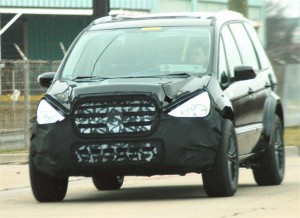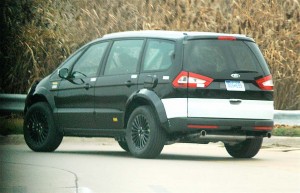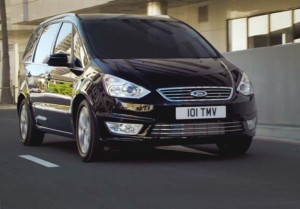Ford is developing a new design and probably engine installation for the next version of its European Galaxy van – or so one would conclude from these shots of a prototype under test at Ford’s home base in Dearborn.
The unanswered question is whether a U.S. version of the Galaxy might be in the works. The maker has been out of the American minivan market since abandoning the largely unnoticed Ford Freestar in 2007. It has since tried to find alternative paths to potential minivan buyers with “people-movers” like the big Ford Flex, the smaller C-Max and an assortment of crossovers.
One look tells the story of the prototype Galaxy’s front end. Despite the heavy camo, it carries an all-new appearance, with a strong block-shape grille opening in place of the current oval. The higher hood line may have two purposes – house a taller, turbocharged (or V6 ?) engine, and change the Galaxy’s appearance to that of a small SUV from the minivan shape it now displays. Those front-hinged rear doors clearly identify – to American shoppers – this vehicle as a small SUV.
While the body of the test car from the windshield rearward is pure today’s Galaxy, the rear shot shows an interesting change. Note the dual tailpipes. There are no such arrangements on any Galaxy that I’ve seen (being a Detroiter, I’ve not kept up with European models). Those pipes indicate a larger engine than a standard breathing 4-cylinder is being tested for the future Galaxy. A V-6 in the works? Maybe. Remember the higher hood profile mentioned earlier. That’s another clue to the bigger engine size.
You might also take note of the wheel styling on the proto. There is nothing in the Ford of Europe catalog that comes close to that multi-spoke arrangement. What the intricate design indicates is a higher priced model, one that will move upscale in Ford’s marketing/pricing plans.
Even more telling from the wheel design is its five-lug attachment. Nowhere on current Galaxys do you see more than a 4-lug wheel type. What does that mean? To any gearhead it says one thing – Galaxy is moving up in power or weight, maybe both. The five lugs are standard on most standard vehicles where the wheels have little weight and power to deliver to the pavement. Check it out on your own car. Is it 4-, 5- or 6-lug? Tell me the answer and I can come close to what kind of power and weight you drive around.
Notice the wheels stick out from the fenders? That’s another indicator that the future vehicle will move up in class, have wider track and wider body – providing more interior space,
Add all the pieces together and you can come up with a number of conclusions:
– Galaxy’s styling will be revised dramatically within two years. That’s a no-brainer.
– More powerful engine will be installed, probably a turbocharged 4 (more exhaust pipe capacity), possibly a small V6?
– Future Galaxys will offer a more robust chassis, one capable of handling the higher power of new engines.
– Galaxy will move up in price rankings with the introduction of a stronger, more powerful vehicle and obvious higher level styling cues.
– A wider, probably longer, body will sit atop the enhanced chassis.
One other major conclusion (speculation?): Galaxy will be shipped to the U.S. market (or built there) where it will compete with vehicles like Honda CR-V, Toyota RAV4 in the small SUV market. Or …… Ford is planning a small SUV for its revamped Lincoln line. This would fit in nicely with the enhancements needed to meet Lincoln’s luxury theme.
Prototypes of this type, with just the front clip covered up, are typically spotted on public roads two years before their public sale dates. Development engineers test the drive train – engine, transmission, front chassis extensions, cooling/AC – first, that’s why you see the major differences in Galaxy’s front end, exhaust, wheels and track. By using the current body style – top-hatting – they avoid the wait for the new body design to be built. In addition, there is no need to cover/disguise the whole vehicle with camo, a process that development engineers dislike.
Photos and text courtesy: Jim Dunne CAR SPY



